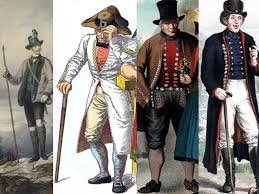Gender and sexuality: fashion Three early twentieth century outfits worn by middle to upper class German women and men In Germany of the year 1905 was a time of social change where fashion was a representation of a society in between tradition and the progress that came with Industrialization. He considered that for a 24-year-old male of this era, clothing was a combination of utility, ostentation and conformity to the societal roles setting with regard to class and profession.
Formal Attire: The Quintessential Gentleman
During official functions or other official & corporate events, young men wore suits that mirrored the Edwardian fashion that dominated Europe. Key components included:
- Tailored Frock Coats or Morning Coats:
These coats, which where mostly black or, dark grey, where the epitome of sophistication. A frock coat was fairly fitted, knee length with a slight flare at the bottom; a morning coat, however had a curved front popularly referred to as the cutaway.
- Waistcoat (Vest):
The waistcoat was an important part of the layers, it could be made of wool or silk or any other fine fabric. Hopelessly fashionable accessories ranged from cream or pastel piece to avoid compare with darker coats.
- Trousers:
Most were high-waisted and tailored, but made from wool or tweed . They were close to the body and were usually worn with suspenders (braces) which would cinch them up properly.
- Shirts:
Black suits, non-ironed blue shirts, and cravats were the order of the day: all worn with detachable stiff collars. These were white and worn together with cravats or bow ties to enhance Smartness.
- Accessories:
These included pocket watches, gloves and the ever essential walking canes. Toppers or bowlers were worn for occasions signifying class and decent conduct of manner.
Everyday and Casual Wear
For less formal settings, the attire became slightly more relaxed while still maintaining a dignified appearance:
- Sack Suits:
This made sack suits less formal and more functional when compared for instance with the more stylised frock coat. These became trendy for the young men who were embracing the modernity.
- Shirts and Neckwear:
Shirts that were coloured or had certain patterns were being worn during casual occasions. Ascots, ties, or neckerchiefs were worn for spices.
- Footwear:
Lacing was fashioned and boots were standard issues, which could be made from leather. Out door activities required stronger boots.
- Outerwear:
Cloaks such as the Chesterfield or overcoats out of wool guarded from the severe conditions in winter in Germany.
This cross-section of the proposed Covid-19 vaccine has thus far been influenced by cultural and social factors.
By 1905, new industrialisation was present Germany’s fashion influence as well as a well-established tradition of its military. Boys wore their suits more tailored, their trousers more form fitting, and their lapels more shapely Infantry and Marine details such as brass buttons, high turn down collars and…and what were those called… OH! Yes… the uniform?
In the youth, especially at the rural places the young men put on Bavarian or Prussian folk costumes during festivals. Men of rural Germany wore lederhosen, woolen jackets, and brown felt hats that were decorated by feathers.
The Fashion Evolution
In getting into the 20th century, there was the beginning gradual evolution to the ready made wears due to industrialization. It appears that while made-to-measure suits continued to be common among the elite, other young men emerging as our subject, 24-year-old may have begun to incorporate ready-made suits and thus opened up fashion to the masses.
conclusion:
All in all, the clothing of 24-year-old German male, which he would wear in 1905, could be considered as interesting combination of formalisms, tradition, and tendency towards the new spirit of the epoch. Whether the Season was spring and he was strutting through the concrete jungle of a German city in his fine tailored suit, or serving up Lederhosen for some country hoe-down the man as a symbol of German fashion must have been a clothes horse’s wet dream.

